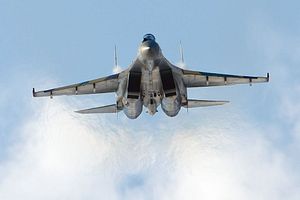The People’s Liberation Army Air Force (PLAAF) is slated to receive a batch of 10 Sukhoi Su-35S (NATO reporting name: Flanker-E) multirole fighter jets from Russia in 2018, Russian Interfax news agency reported last week, citing Rostec corporation.
China signed an estimated $2.5 billion contract for 24 Su-35 fighter aircraft in November 2015. As I reported previously (See: “Christmas Day Gift: China Received 4 Su-35 Fighter Jets From Russia”), the first four Su-35 fighters arrived at a flight training center of the PLAAF in Cangzhou City in Hebei province in northern China in December 2016. A second batch of 10 Su-35 fighter jets was delivered in December 2017. As part of the contract, Russia is supplying pilot and maintainer training, as well as ground and other logistical support.
China has been mulling the procurement of Su-35 fighter jets for a decade, with official negotiations kicking off in 2011. A first agreement between Beijing and Moscow was concluded in 2012.
The per-unit cost of a Su-35, the latest variant of Russia’s Flanker-series, is estimated at around $85 million. The Su-35 is an upgraded fourth generation, twin-engine, multirole air superiority fighter aircraft powered by two AL-117S turbofan engines and fitted with thrust vectoring nozzles allowing the aircraft to attain “super maneuverability”.
Additionally, the aircraft features “an export-standard radar system — the Irbis-E passive-electronically scanned-array radar, capable of tracking up to 30 targets simultaneously and purportedly able to engage up to eight — an electronic warfare and communications suite, as well as a newly integrated receiver for the domestically-built BeiDou satellite navigation system,” I wrote earlier this year.
As I noted previously, China’s military aircraft industry is particularly interested in the Su-35 because of its jet engine (See: “China to Receive 4 Su-35 Fighter Jets From Russia in 2016”):
One of the reasons for China’s interest in the Su-35 is its AL-117S turbofan engine. Russia has repeatedly refused to sell the engine as a stand-alone product, which left the PLAAF with little choice but to acquire the entire aircraft. The Chinese military aviation industry is still struggling with designing and building an engine for its new fifth-generation stealth fighter prototype, the Chengdu J-20.
According to a number of sources, Chinese aircraft manufacturers are involved in reverse engineering parts of the AL-117S turbofan engine to build a next-generation high-performance turbofan jet engine.
An unknown number of PLAAF Su-35s for the first time escorted an undisclosed number of People’s Liberation Air Force (PLAAF) Xian H-6K bombers and support aircraft during a long-range patrol over the Bashi channel and around the island of Taiwan on May 11.
































